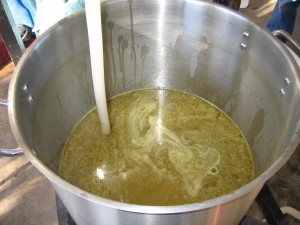As I mentioned in the article on tannins in the mash, most of the tannins in your beer come from malt and are extracted during the mash. The major procedural thing you can do to avoid extracting excessive amounts of tannins is not to oversparge — do not continue collecting wort when the pH rises above 5.8. (This assumes your mash is at 170 °F (77 °C) at the end of wort collection.) If you don’t have a pH meter, the cutoff point for wort collection usually coincides with the specific gravity of the final runnings dropping to 2–3 °Plato (SG 1.008–1.012). You can also cool down a sample of your final runnings and taste them. You will feel the astringency increasing near the end of wort collection. (Astringency is a mouthfeel, not a taste.)
Hops also contribute tannins to your beer. However, if your sweet wort — the wort you collected from your lauter tun, not yet hopped — is OK, you really don’t have to worry further much about tannins. And this is good, since your only real way of controlling hop-derived tannins is to change the amount of hops you use.
Before we go on, recall that tannins are water soluble. Anytime tannic plant material is in an aqueous environment, tannins are dissolving into the liquid. Heat, pH and time are the major variables in tannin extraction. In the mash, the combination of temperatures 170 °F (77 °C) and over, coupled with a pH of 5.8 or greater, leads to tannins being very soluble. However, those conditions are not an “off and on” switch. In a mash at 160 °F (71 °C) at a pH of 5.6, tannins would dissolving into the wort, only at a much lower rate. Finally, recall that tannins are always present in beer — they are only a problem if their concentration is high enough to cause astringency.
Boiling Hops
Hops contain 2-5% tannins by weight. In the boil, they exposed to temperatures around 215 °F (103 °C) for up to 60 minutes, and occasionally longer. Although by weight they are only a small percentage of the ingredients, and the pH in the boil is generally 5.0–5.2, they still contribute a significant amount of tannins to your beer. (Kunze gave 20% as a figure.)
There really is nothing you can do about this other than ensuring your boil pH is correct. If your boil pH was higher than it should be, you would extract more tannins from the hops. Making sure your boil pH drops to 5.2 or below will limit tannin extraction (but also hop utilization, incidentally). Many times boil pH will take care of itself. If it doesn’t, add a little calcium to the boil. Proper boil pH is required for big pieces of hot break to appear, so you can always do a visual check of the kettle.
If you were brewing a beer with a lot of hops, and could find T-45 hops pellets or liquid hop extract to use for bittering, this would also help. T-45 pellets have roughly half of the plant material removed from them, compared to T-90 pellets, which are what homebrew stores sell. Hop extract doesn’t contain any tannins.
If you are boiling spices other than hops, be aware that they may be tannic as well. If you are going to boil them, do so for the shortest tim that still extracts the essential oils you’re after.
Other than boil pH, the only other thing you can do to limit tannins is to boil vigorously. A hard boil will cause tannins and proteins to coagulate (as hot break) and form an insoluble complex. Break material is formed from tannins from the grains, carried into the kettle, and tannins from the hops. A hard boil also contributes to good cold break formation. If the break material is not carried over to the fermenter, those tannins are removed from the brewing stream.
So, a good, hard boil — which is beneficial for several reasons — coagulates many of the malt tannins extracted during mashing. However, tannins are also added to the wort by boiling the hops. Other than ensuring proper boil pH, your only real control on tannins comes from the amount of hops you add and how long you boil them — and these amounts are determined by your goals for hop bitterness and aroma.
Dry Hopping
When beer is dry hopped, the hops are exposed to the beer at low temperatures (refrigerator temperature is optimally around 38 °F/3.3 °C) and at a low pH (4.0–4.4 is common for non-sour beers). However, the contact time is at least several days. This does extract tannins, and this is part of the reason that dry-hopped beers are usually hazy. (One form of beer haze is protein-polyphenol haze. Hops also contain around 15% protein, so that also contributes to the haze.) When dry hopping, remove the hops once the aroma from the dry hops has been imparted to the beer.
Barrel Aging
Obviously, if you age your beer in barrels, you could introduce tannins to your beer. If you aged beer in new oak, you’d get a lot of tannins (along with the vanilla and other oak flavors). Other barrels, such as bourbon barrels, used wine barrels, barrels used for aging previous beers (including sour beers) are going to vary in how much tannin is left in the wood. If the barrel isn’t neutral, the long contact time of barrel aging is sure to extract some the remaining tannins. Of course, the tolerance for tannins in wood-aged beers is higher than in normal beers, so that may not be a bad thing. In general, stay away from new oak and sample beer as it ages if there’s any chance of it picking up too much oak in the barrel.
Conclusion
Astringent beer is caused by an excess of tannins, polyphenolic molecules found in a variety of plant tissues. In beer, tannins come from the husk and aleurone layer of the barley malt and the bracts and strigs of other hops. Simply by following sound brewing procedures, you will likely avoid brewing an astringent beer. The biggest control you have over tannins is the amount of wort you collect — if you stop collecting wort when the grain bed is on the verge of being oversparged, you should be fine. A good hard boil, required for many reasons, coagulates some of the tannins extracted in mashing and lautering. For very hoppy beers, replacing some of the bittering hops with hop extract (or T-45 hop pellets), may also help.




I have not found dry hopping in the keg to impart all that much haze. Maybe I have been lucky? Most of my APAs will sit with 1 ounce or so in the keg till it kicks. That said – dry hopping at room temperature – when I secondaried – I seemed to pick up some haze.
Time and temperature play a role, as does the amount of hops added. In addition, oxygen in the beer will oxidize the polyphenols, which also leads to haze.
Have you compared to of the same beers, one dry hopped and one not, side by side? Dry hopping doesn’t ensure the beer becomes downright cloudy. (You can see the dry hop haze in most commercial IPAs.)